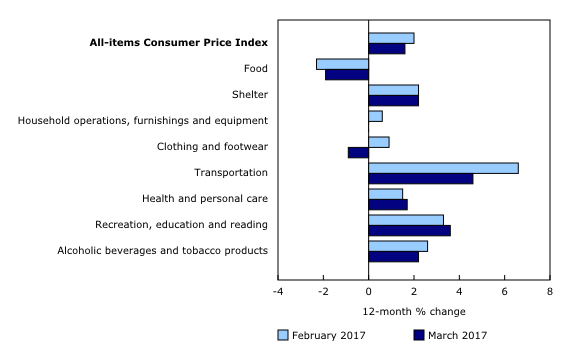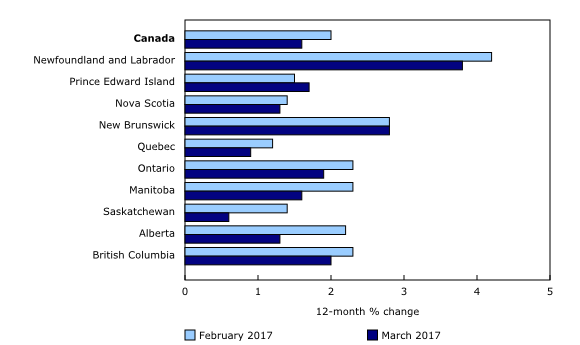Consumer Price Index, March 2017
Archived Content
Information identified as archived is provided for reference, research or recordkeeping purposes. It is not subject to the Government of Canada Web Standards and has not been altered or updated since it was archived. Please "contact us" to request a format other than those available.
Released: 2017-04-21
March 2017
1.6% 
(12-month change)
The Consumer Price Index (CPI) rose 1.6% on a year-over-year basis in March, following a 2.0% gain in February.
Excluding food and energy, the CPI was up 1.7% year over year in March, after posting a 2.0% increase in February.
12-month change in the major components
Prices were up in five of the eight major components in the 12 months to March, with the transportation and shelter indexes contributing the most to the year-over-year rise in the CPI. The food index and the clothing and footwear index declined year over year, while the price index for household operations, furnishings and equipment was unchanged.
Transportation costs rose 4.6% over the 12-month period ending in March, after increasing 6.6% in February. The increase in transportation costs, as well as the deceleration in the growth of these prices compared with the previous month, was led by the gasoline index. On a year-over-year basis, gasoline prices rose 15.2% in March, following a 23.1% increase in February. The purchase of passenger vehicles index was up 2.1% in the 12 months to March, following a gain of 3.6% in February.
The clothing and footwear index fell 0.9% year over year in March, following a 0.9% increase the previous month. This turnaround was led by a decrease in the women's clothing index, down 1.0% in March, following a 3.5% increase in February. A larger year-over-year decline in the children's clothing index (-4.4%) in March, compared with February, more than offset a 0.3% increase in the footwear index.
Consumer prices for food were down on a year-over-year basis for the sixth consecutive month, dropping 1.9% in March. Prices for food purchased from stores declined 3.6% in the 12 months to March. Meanwhile, prices for food purchased from restaurants posted a 2.4% increase.
Shelter cost increases in March matched those of February, up 2.2% on a year-over-year basis. The homeowners' replacement cost index was the main upward contributor to the 12-month change in the shelter index, up 4.0%, despite slowing growth since November 2016. At the same time, rent increased 0.6% year over year, after posting a 0.5% increase for six consecutive months.
The recreation, education and reading index rose 3.6% in the 12 months to March, following a 3.3% gain in February. This acceleration was led by the travel tours index, up 6.8% in March, following a 0.5% decline the previous month. In contrast, traveller accommodation prices rose less in March than in February.
12-month change in the provinces
In eight provinces, consumer prices rose less on a year-over-year basis in March than in February. The 12-month increase in the CPI in New Brunswick was unchanged from a month earlier, while consumer price growth in Prince Edward Island accelerated year over year in March.
The CPI in Saskatchewan posted a 0.6% gain in the 12 months to March, after increasing 1.4% in February. Traveller accommodation prices fell the most in Saskatchewan (-8.2%) among the provinces on a year-over-year basis in March. At the same time, prices for telephone services declined more in Saskatchewan (-14.3%) than at the national level (-3.1%) in the 12 months to March.
The Government of Saskatchewan increased the Provincial Sales Tax (PST) from 5% to 6%, effective March 23, 2017. For products and services newly subject to PST, the tax change came into effect April 1.
In New Brunswick, consumer prices rose 2.8% year over year in March, matching the gain in February. The gasoline index posted a 20.7% gain in the 12 months to March, following a 21.8% increase in February; this marked gasoline's smallest contribution to the deceleration in the 12-month change in the CPI among the provinces. The recreational equipment and services index was down less year over year in March than in February.
Consumer prices in Prince Edward Island were up 1.7% on a year-over-year basis in March, following a 1.5% gain in February. The traveller accommodation index rose 5.2% on a year-over-year basis in March, after declining 4.0% in February. In addition, prices for clothing and footwear fell less in March than in February.
On a month-over-month basis, the telephone services index posted increases in all the Atlantic provinces, while posting declines in Western Canada.
Seasonally adjusted monthly Consumer Price Index
On a seasonally adjusted monthly basis, the CPI declined 0.2% in March, after falling 0.3% in February.
In March, three major components decreased on a seasonally adjusted monthly basis and five increased.
On a seasonally adjusted monthly basis in March, the transportation index (-1.1%) posted the largest decline, while the recreation, education and reading index (+0.6%) recorded the largest increase.

In celebration of the country's 150th birthday, Statistics Canada is presenting snapshots from our rich statistical history.
From 1961 to 2016, the annual average Consumer Price Index (CPI) grew 3.9% per year on average. Until 1995, prices for durable goods followed a similar trend, rising 3.3% annually on average. Since then, consumers have seen price declines for durable goods, averaging a 0.5% decrease annually, led by declining prices for computer, video and audio equipment. Comprising more than one-tenth of Canadian household expenditures in scope of the CPI, durable goods include products such as household appliances, passenger vehicles and computers.
Note to readers
A seasonally adjusted series is one from which seasonal movements have been eliminated. Users employing Consumer Price Index (CPI) data for indexation purposes are advised to use the unadjusted indexes. For more information on seasonal adjustment, see Seasonally adjusted data – Frequently asked questions.
Real-time CANSIM tables
Real-time CANSIM table 326-8023 will be updated on May 8. For more information, consult the document Real-time CANSIM tables.
Next release
The CPI for April will be released on May 19.
Products
The March 2017 issue of The Consumer Price Index, Vol. 96, no. 3 (62-001-X) is now available.
More information about the concepts and use of the Consumer Price Index (CPI) is available in The Canadian Consumer Price Index Reference Paper (62-553-X).
For information on the history of the CPI in Canada, consult the publication Exploring the First Century of Canada's Consumer Price Index (62-604-X).
Two videos, "An Overview of Canada's Consumer Price Index (CPI)" and "The Consumer Price Index and Your Experience of Price Change," are available on Statistics Canada's YouTube channel.
Contact information
For more information, or to enquire about the concepts, methods or data quality of this release, contact us (toll-free 1-800-263-1136; 514-283-8300; STATCAN.infostats-infostats.STATCAN@canada.ca) or Media Relations (613-951-4636; STATCAN.mediahotline-ligneinfomedias.STATCAN@canada.ca).
- Date modified:






